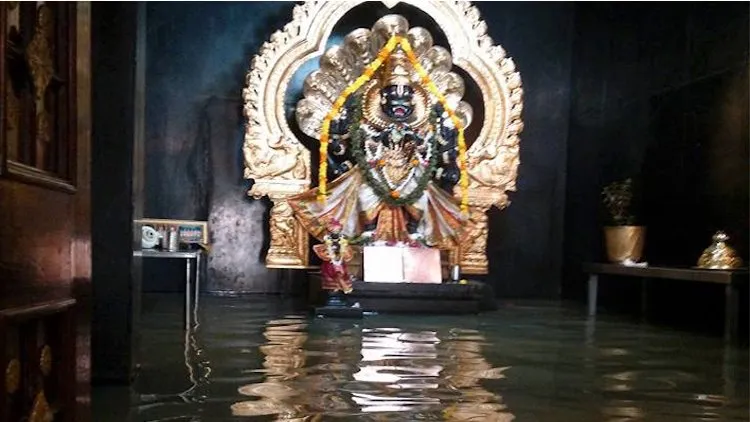Jharni Narsimha Mandir in Karnataka

Our country is adorned with thousands of temples and tirthas, as per the shastras, there are almost sixty thousand crores of such places. Each of these tirthas is significant and has the power to bestow spiritual liberation upon its seeker. Notably, South India boasts a multitude of temples dedicated to Bhagwan Narasimha.
There are temples of Bhagwan Narasimha situated deep inside the forest, some on the banks of vast rivers, some in the inaccessible caves, some on the edge of the waterfalls, some below the ground and there is only one temple where Bhagwan Narasimha is worshipped within the water. Yes, this is true, it happens in Jharni Narasimha Temple.
The Narasimha Jhira Cave Temple or the Narasimha Zarna Cave Temple or Jharani Narasimha Temple is a place devoted to Bhagwan Narasimha, the divine lion incarnation, the 4th Avatar of Bhagwan Vishnu. This temple is located within a cave, where devotees undertake a unique pilgrimage journey, wading through water as they make their way to worship Bhagwan Narasimha. People utter the words Govinda-Govinda and Narasimha Hari-Hari with devotion as mantras.
The other names of the temple are:
-
Jharani Narasimha Cave Temple
-
Jharni Narasimha Swamy
-
Jharani Narasimha Temple
-
Narasimha Swami Jharani Temple
-
Narasimha Jhira Cave Temple
-
Narasimha Jhara
Let us tell you what makes Jharni Narsimha Mandir in Karnataka so significant which attracts people from thousands of kilometres.
Significance of the Jharni Narsimha Mandir
The Deity enshrined within is a Swayambhu, taking the form of a Shaligram – signifying that the Deity is self-manifested and possesses formidable power. An exceptional characteristic of this temple is the unique practice of having darshan while wearing wet clothes, making it an unparalleled place of worship unlike any other found anywhere in the world.
A pilgrimage to the Narasimha Jhira Temple is believed to grant the fulfilment of all the devotee’s desires.
Also, the sage Vidura once resided in the sacred precincts of the Jharni Narasimha Temple, earning it the alternate name of Viduranagara. Also, the powerful King Nala, a prominent figure in the Mahabharata, crossed paths with Damayanti in this very place.
Pilgrims, in a unique tradition, carry children on their shoulders as they enter the temple. The temple’s therapeutic waters are believed to bring relief to devotees suffering from skin ailments. Also, this temple holds special significance for couples seeking the blessings of a child.
History Behind the Narsimha Mandir
As per history, Bhagwan Narasimha killed the demon king Hiranyakashyap, who wanted to harm the Bhakt Prahlad of Narayan. Afterwards, the Bhagwan also confronted and conquered another demon by the name of Jharasura (Jalasura). Remarkably, Jharasura was an ardent devotee of Bhagwan Shiva.
As Jharasura neared the end of his existence, he implored Bhagwan Narasimha to take up residence within the cave he called home, with the intention of bestowing blessings upon the throngs of devotees who would come to worship him there. Bhagwan Narasimha graciously granted Jharasura’s wish, remaining within the cave, while Jharasura transformed into a flowing stream at the divine feet of Bhagwan Narasimha. Because of that reason, this temple is also recognized by the name “Jala Narasimha Swamy Temple.” Within the Garbagraha of the Jharni Narasimha Temple, there lies a Shiva Linga, as per the Shiva Purana, which was venerated by Jharasura.
Jharasura, the demon, was the one who meticulously excavated this cave with his very fingernails. Remarkably, even to this day, the imprints of his fingernails can still be discerned on the cave’s walls.
The most favourable time for a pilgrimage to this temple is during the winter season. Summers in this region can be exceptionally scorching. Therefore, December and January offer the best weather for visiting Sri Jharni Narasimha Temple. So, plan your next trip here. But only planning won’t help, pray as well to Bhagwan Narayan, to allow you to seek his blessings. After all, we think we have free will, but it is the Paramatma who calls us!
Frequently Asked Questions
Q: What are the timings of the Bidar Narasimha Swamy temple?
A: The Bidar Narasimha Swamy temple is open from 8 AM to 6 PM.
Q: How can one reach Bidar Narasimha temple?
A: One can either take an air, rail, or road route to the Narsimha Mandir in Karnataka.
-
By Air: Bidar’s closest airport is the Begumpet International Airport in Hyderabad, which is approximately 120 kilometres away.
-
By Train: Bidar enjoys efficient rail connectivity with both Hyderabad and Bangalore. Travellers can also opt for a train to Gulbarga City, followed by a bus journey to Bidar, which typically takes around two and a half hours.
-
By Road: Regular private bus services operate along the Bangalore-Hyderabad route via NH 7 and NH 9, with the journey lasting approximately 16 hours. Bidar is located at a distance of about 114 kilometres from Hyderabad, and Zahirabad in Telangana is approximately 31 kilometres away.
If you are looking for astrological or spiritual remedies, you can reach out to our astrologers and pandits here.








